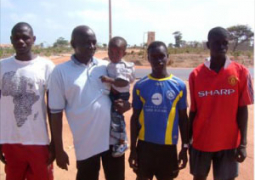The exercise will target vitamin A deficiency and worm infestation for children 9 months to 14 years for measles and Rubella and 6 months to 5 years for vitamin A and mebendazole.
The vaccination dates are from 25 April to 1 May 2016.
The measles and rubella vaccination campaign will target all persons aged 9 months to 14 years (less than 15 years) using a dose LYOPHILISED MR vaccine as the preferred choice of vaccine presentation.
A total of 802,245 persons has been targeted for the campaign. It is expected that measles-rubella vaccines will be subsequently introduced nationwide into the routine EPI programme in 2016.
Mobile vaccination teams will move from community to community to reach targeted children in schools, bantabas, churches, mosques, marketplaces, and transit points during the immunization campaign.
Speaking at the ceremony held at the Central Medical Store in Kotu, Kebba Gibba of WHO told reporters: “We have been having measles campaign all along but this one is different from the usual one because there are two components in one; that is the measles and rubella.
He noted that rubella is called German measles and usually affects pregnant women, and may result in miscarriage.
“In the country we have not been having measles cases; it was only last year that we had few cases and there is what we call displacement,” Mr Gibba said. “If you have more measles the rubella goes down but if you less measles the rubella shows up and to avoid that we bring the two vaccines together. This has been introduced in other countries like Senegal and Ghana. The Gambia being one of the strong countries in terms of immunization it is going to be an easy way through.”
Fatou Jankeh Jawara of NaNa, in her remarks, said Vitamin A is very important in the body for small quantity supplement. “However the small quantity is very vital,” she said, adding that that the upcoming campaign is important and “we all can join hands together to try and tackle this micro nutrients deficiency problem”.
For his part, Dawda Sowe, Expanded Programme on Immunization (EPI) Manager, said: “This is the first time in the history of The Gambia to integrate a two-in-one measles rubella vaccines because this two diseases are actually distinct but synonymous to each other.”
According to EPI data, a total of 135 suspected measles cases were identifies in 2013 highlighting 66 (49%) cases for rubella IgM positive and none for measles.
In the same report, a total of 93 suspected measles cases was identified in 2012 out of which 39 (42%) were rubella IgM positive and none for measles and a total of 114 suspected measles cases was identified in 2011 of which 42(37%) were rubella IgM positive and none for measles.
In this regard, with the presence of rubella as shown in the surveillance data, the Government of The Gambia deemed it fitting to conduct an MR vaccination campaign, Mr Sowe said.
The programme was chaired by Modou Njai, director of health promotion and education directorate.



